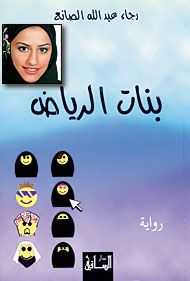Romeo and Juliet in Saudi Arabia, and Romeo’s a big disappointment
Written by a young 20-something Saudi woman, now studying dentistry in Chicago, the book was first published in Lebanon in Arabic (Banat Ar-Riyadh) in 2005, evoking a firestorm of debate and criticism around the Arab world and, of course, in Saudi Arabia, where it was originally banned and where a group of Saudi citizens filed suit against the author for slandering Saudi society.
For ReligionWriter, who recently spent two years living in Muscat, Oman, the details of life on the Saudi peninsula were perfectly evoked: the elaborate sex-segregated wedding celebrations, the text-messaging-based culture of the young urban elite, the desperate practice of young men “numbering” young women (i.e. throwing their phone numbers at women they glimpse but are unable to socialize with because of social norms.) But because the book’s author is a Saudi woman herself, the book brings the reader far past the Lonely Planet-type descriptions of cultural context: Al-Sanea shares with us the story of four young women as they search for love in a culture where family-approved marriage often wins the day.

The stories themselves are as entertaining, if not more so, than any episode of “Sex in the City.” One character is married off to a successful young Saudi living in the U.S., who, it turns out, is in love with an Asian-American woman his family forbid him from marrying. Two other characters fall in love with men unable to buck their families insistence that they marry a certain kind of girl — that is, one from the “right” family with the “right” reputation. At moments, the reader might feel like they are reading about Western culture in an earlier era, when being divorced was a stigma a woman could almost never live down, when a young adult woman with no parents was forced to move in with relatives rather than risk the “scandal” of living alone.
But more than anything the stories evoke the timeless story of Romeo and Juliet — two lovers separated in no uncertain terms by their determined families. That story’s romance lies in the commitment both characters have to their love and their vision of living out that love in real life. In AlSanea’s stories, however, Romeo appears sadly lacking in such a commitment. AlSanea portrays most, though not all, of the young Saudi men in her book as, in the words of one of the female protagonists, “passive and weak.” This woman, Mashael, who dumped the love of her life when he confessed that his mother disapproved of their romance and would not allow them to marry, had this to say of Saudi men:
They are slaves to reactionary customs and ancient traditions even if their enlightened minds pretend to reject such things! That’s the mold for all men in this society. They’re just pawns their families move around on the chessboard!
But the book is not without hope: one character, at least, is married to a Saudi man who loves and respects her. And while some critics have savaged the book’s main characters, saying these upper-class young women seek only the frivolity of passionate love, the author suggests that love is a force powerful enough to change a society so resistant to change.
For a Western audience, the book is a first-of-its kind, and its value lies in introducing readers to this unfamiliar world that is surprisingly familiar. As the author writes in her forward to the English edition:
I hope by the time you finish this book, you will say to yourself: Oh, yes. It is a very conservative Islamic society. The women there do live under male dominance. But they are full of hopes and plans and determination and dreams. And they fall deeply in and out of love just like women anywhere else.
Related elsewhere: “‘Girls of Riyadh’ spurs rush of Saudi novels,” Reuters, June 23, 2007

Comment by someone somewhere on 19 August 2007:
Marhaba,
yeps i can say that i fully udnerstand what this book is about. have been in khaleej now for 20 years, soo many positive things here but sadly as we read from this book, the open mindedness about saudi locals marrying to non saudi locals is something of a deep forbidden thing by society etc etc ….
many women i know from saudi are suffering and want to marry but untill the males allow them they are dealing with depression, chronic sickness, loss of hair and body weight some have given up all hope and just drifted to a land of sorrow and tears. it brake my heart my sisters in islam face this but its all to familiar to people of western backgrounds who have met these saudi men in usa and uk etc etc and wish to marry them. its either they leave saudi for life and the kids dont ever get to go to mekkah or see their ghrand parents or the passport get removed and jail is sentenced.
its all hush hush.
May Allah help us all.Ameen